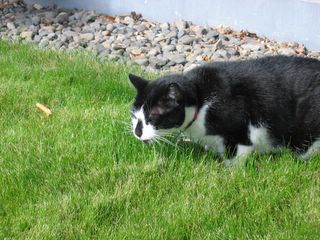Our garden "experiment" was definitely a learning experience. I'll try to summarize the experiment here, so will likely be a longer post than most. I give each crop a score from 1 to 10, based on how successful I think we were in growing, harvesting and consuming it.
Tomatoes: 7/10Our tomatoes did fairly well, and we actually did a good job of choosing varieties for our short growing season. The 2 golden nuggets produced first (and in abundance!), followed by the plums and then the beefsteaks. The latter two were just starting to get into full swing when the frost took them out. We had minimal impact from wildlife (once we put the circular fence around them.)
Lessons Learned: Adding a ground cover of some sort - plastic, etc. - should help to keep the ground warmer and encourage the tomatoes to produce earlier
Lettuce & Spinach: 6/10Deer like lettuce - particularly when you put the
hot pepper spray "salad dressing" on it. Thankfully, most of it came back from the roots in time to harvest before the summer heat.
Lessons Learned: Harvest! Lettuce will bolt fairly quickly once the weather gets warmer. Stagger plantings so that the harvest isn't all at once.
Beets: 2/10Lost to deer. The beets were growing nicely, and we had protected them from animals by arching some metal fencing over the top of the bed. Unfortunately, the deer eventually figured out the weakness of our defense system: you can step on it. So they crushed the fence underfoot and just plucked the beets out through the fencing by the leaves.
Lessons Learned: Deer like beets. Need more protection.
Zucchini: 5/10Grows well, wasn't impacted by wildlife. I'm sure the prickly leaves are the primary reason. The biggest problem we had here was confusing the zucchini seedlings with the leeks. The result was a cluster of 5 zucchini bushes planted 6” apart.
Lessons Learned: Once they start producing, check and pick frequently; the fruit will grow quickly and become more bitter, suitable primarily for baking.
Basil: 6/10We replanted some basil after the worst of the summer heat had passed, so we actually got two crops.
Lessons Learned: Harvest! Lots of basil went to waste because we didn't harvest before either the plant bolted or was killed by frost.
Leeks: 0/10Yes, zero. Despite planting the ends of several beds with a dozen or so leeks a piece, none were found. Then there was the mix-up with zucchini.
Lessons Learned: Pay better attention when planting seeds and transplanting.
Potatoes: 3/10This was probably the biggest disappointment. Since the Clausens had specifically mentioned that root crops do best, we planted an entire bed in fingerling potatoes. The plants looked great, and we had high hopes for a good crop. But when we harvested, we discovered a gopher tunnel that spanned the entire length of the bed. We should have harvested ~20# of potatoes, but only ended up with ~2#! Bastards!
Lessons Learned: Gophers are the devil incarnate.
Cucumbers: 0/10We planted the seedlings, and they promptly disappeared into the weeds.
Lessons Learned: Weeding is important, particularly when the seedlings are small.
Parsley, Oregano, other herbs: 1/10The parsley came up, and we did use it a few times, but none of the other herbs (besides the basil) survived.
Lessons Learned: Plant more herbs!
Peppers: 2/10The peppers were close to harvestable when the frost arrived, so we didn't actually get to eat any. They also suffered from some deer munching.
Lessons Learned: Better protection around the peppers. Add mulch to increase temperature and speed growth.
Flowers: 9/10The unsung heroes of our garden! Sunflowers and 2 varieties of marigolds did great in our garden. We even harvested lots of seeds from them to plant next year!
Lessons Learned: Choosing a plant variety that the wildlife doesn't like to eat makes all the difference!


Some overall thoughts/plans for next year:
- Add “real” protection from wildlife.
We're thinking of actually creating raised beds in our garden plot, with several layers of metal screen on the bottom to keep the gophers out. We're also thinking about a fence to keep out the deer.
- Plant more flowers.
The flowers we did plant looked great and survived all manor of wildlife.
- Weed early!
We lost – literally – many of the seedlings that we planted because we didn't mark them well enough, and we waited too long before weeding.
- Plant more!
Our goal was to start small so that we could see what worked, but I think we actually started a little too small.
- Harvest!
That's the ultimate goal of having a garden, isn't it?
I plan to post my "Favorite New Recipes for 2006" sometime before the end of the year, which will include many things harvested from the garden!
- Mike (& Corinne)






































